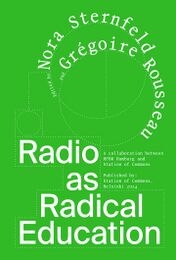User:Eleni/Radio as Radical Education: Difference between revisions
No edit summary |
No edit summary |
||
| Line 21: | Line 21: | ||
↘ ...''the question of the power of archives as <mark style="background-color:#a0fe99">pockets of radically imagining other possibilities</mark>. We already talked about how radio practices can, I think, in a very specific moment in time, <mark style="background-color:#a0fe99">be a way of responding; also responding in a world that is very much talking to us and making us listen.</mark>Even though this world pretends to invite us to participate by clicking on something, <mark style="background-color:#a0fe99">we are actually reduced to listeners of not only the existing truth regime, but of ubiquitous publicity.'' </mark> | ↘ ...''the question of the power of archives as <mark style="background-color:#a0fe99">pockets of radically imagining other possibilities</mark>. We already talked about how radio practices can, I think, in a very specific moment in time, <mark style="background-color:#a0fe99">be a way of responding; also responding in a world that is very much talking to us and making us listen.</mark>Even though this world pretends to invite us to participate by clicking on something, <mark style="background-color:#a0fe99">we are actually reduced to listeners of not only the existing truth regime, but of ubiquitous publicity.'' </mark> | ||
It is a means of political organizing. People | |||
would phone in to the radio station and say, | |||
“The cops are coming this way. Then we should | |||
organize that way, and so on.” So of course, | |||
it was an amazing real-time form of communication between the activists. | |||
== <span style="color:#31BA26;">References</span> == | == <span style="color:#31BA26;">References</span> == | ||
Revision as of 15:30, 18 October 2024
if you are curious, you can find the full text here or on the bootleg library [1]
A Polyphonic Voice Responding. Introduction
↘ It [the book] brings together the voices and ideas of people who have worked on and with and in radio while understanding their radio projects as education projects or understanding radio as radical education.
↘ Station of Commons was initiated at the beginning of the pandemic in 2020. It’s a research platform on digital commoning practices with a very strong emphasis on audio and radio practice.
↘ The radical education approach wasn’t something we developed deliberately, but something that emerged from the practice itself as we tried to understand how a collective can learn and how this learning can then be shared. This idea of sharing encompasses the idea of communication, the idea of distribution.
↘ trans-local is a new term for me, what does it mean? add to the glossary
↘ how radio was instrumental as it “brought the nation to life and endowed every citizen with a new status.”
↘ narrowcasting opposite of broadcasting?
↘ ...technology is a collective practice that must be reappropriated within public space, and that a truly radical technology produces new expertise and knowledge to be shared at large. technology education as emancipation.
↘ We consider a radio any collective that produces sound. It’s not only this formal idea of the radio: a studio and station with an antenna on the roof that broadcasts on AM/FM frequencies. We think of radio as any collective that wants to share their audio production on a regular basis. For us, that is the definition of radio.
↘ ...the question of the power of archives as pockets of radically imagining other possibilities. We already talked about how radio practices can, I think, in a very specific moment in time, be a way of responding; also responding in a world that is very much talking to us and making us listen.Even though this world pretends to invite us to participate by clicking on something, we are actually reduced to listeners of not only the existing truth regime, but of ubiquitous publicity.
It is a means of political organizing. People would phone in to the radio station and say, “The cops are coming this way. Then we should organize that way, and so on.” So of course, it was an amazing real-time form of communication between the activists.

